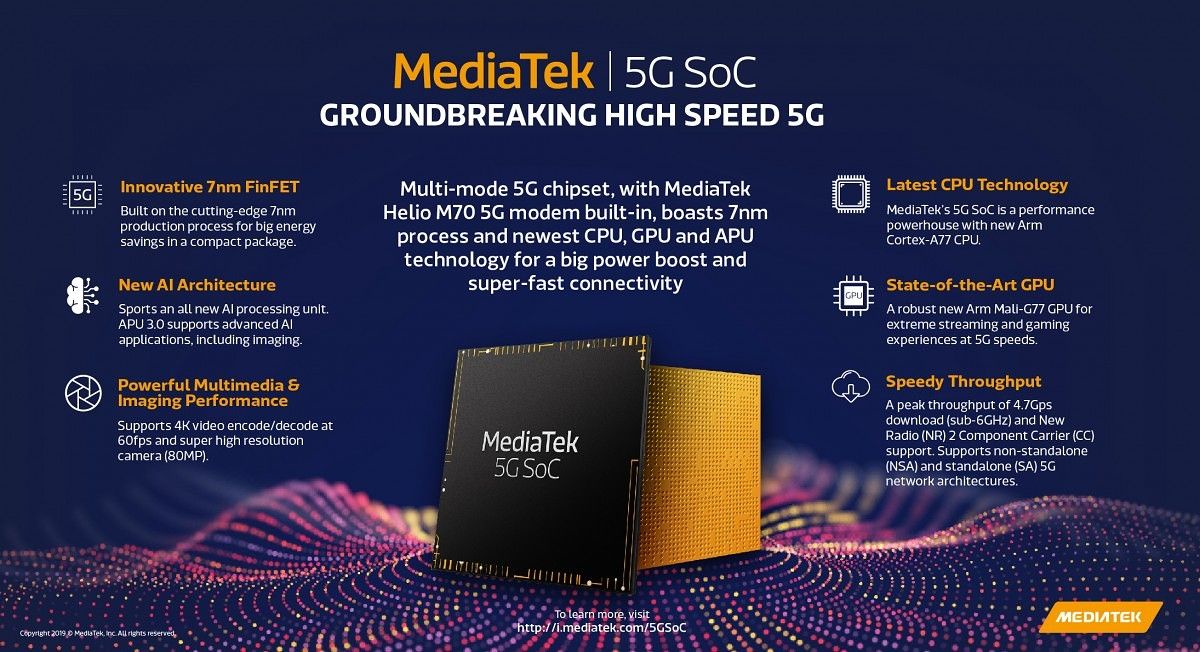It's been a while since MediaTek has made an announcement of a high-end SoC. The company vacated the high-end SoC market in the face of strong competition from Qualcomm after the MediaTek Helio X30 in 2017, which made its way to only two phones. Since then, MediaTek's mid-range P series of SoCs (in particular, the Helio P60 and the Helio P70) have enjoyed success in many mid-range phones made by the likes of OPPO, Vivo, and Realme. Now, MediaTek is back with a very unusual announcement at Computex of a new 5G SoC that is unnamed as of yet. It will feature ARM's latest CPU and GPU IP, and MediaTek says that it's designed to power the first wave of high-end 5G phones.
MediaTek states that the new 5G SoC has an integrated MediaTek Helio M70 5G modem built in. This is interesting as this fact makes it the first announced SoC to feature a 5G modem on-die, rather than having it as a discrete modem. In contrast, the Qualcomm Snapdragon 855 and the Exynos 9820 support 5G through a discrete modem.
The Helio M70 modem is a multi-mode 5G chipset that supports both 5G SA (stand alone) and NSA (non-stand alone) sub-6GHz networks. This means that it supports 2G/3G/4G to bridge existing network access while 5G networks start rolling out in limited scale. It's important to note here that the modem does not support millimeter wave 5G networks (mmWave). mmWave as a technology has only been adopted by US carriers so far, while other carriers across the globe are focusing on sub-6GHz 5G. Both technologies are different on a fundamental level.
The new MediaTek 5G chipset will be integrated with the previously announced Helio M70 to give device makers a comprehensive solution for 5G in a single power efficient package, according to MediaTek. The company states that its single chip 5G design is superior to two chips solutions, especially for power efficiency. It should be noted here that when this SoC makes it to market, Qualcomm and Samsung System LSI will also have SoCs with on-die 5G.
The Helio M70 5G modem features 4.7Gbps maximum download speeds and 2.5Gbps maximum upload speeds, along with multi-mode support for 2G/3G/4G and dynamic power sharing that allocates 5G bandwidth required for specific applications to improve modem power efficiency by 50% and extend battery life, according to MediaTek. It's supposed to have "intelligent power savings" and "comprehensive power management." It has New Radio (NR) 2 Component Carrier support, as well as dual connectivity for LTE and 5G (EN-DC).
MediaTek's 5G SoC has a new AI processing unit that is said to be the company's most advanced yet. The company didn't provide many details about it, but states that it has a new AI architecture. It's said to support more advanced AI applications, with a specific example of de-blur in imaging given so that users can get great photos of fast-moving objects.
Interestingly, the MediaTek 5G SoC is the first announced SoC to feature the latest ARM Cortex-A77 CPU core, which was announced two days ago. This signifies that MediaTek has made a very early preliminary announcement of the SoC. We don't know the exact CPU core configuration yet. The SoC also features ARM's new Mali-G77 GPU, making it a comprehensive next-generation SoC for next year's 5G phones. It will be manufactured on TSMC's "cutting edge" new 7nm FinFET process (this likely signifies that it will be made using TSMC's 7nm EUV process).
The MediaTek 5G SoC supports 4K video encode/decode at 60fps, and cameras with up to 80MP resolution. MediaTek also specifically notes that it is designed for global sub-6GHz 5G networks that are launching in Asia, North America, and Europe. mmWave support will come in future modems. Companies like OPPO, Vivo, are collaborating with MediaTek on 5G technology, while RF suppliers like Skyworks, Qorvo, and muRata design the front end module that can accommodate 5G.
The MediaTek 5G SoC will be ready for lead customer samples in Q3 2019 and will be in commercial devices by Q1 of 2020, according to the company. MediaTek promises to reveal the SoC's full specifications in the coming months. We are interested in learning how this SoC shapes up in the wider SoC landscape.
Source: MediaTek


